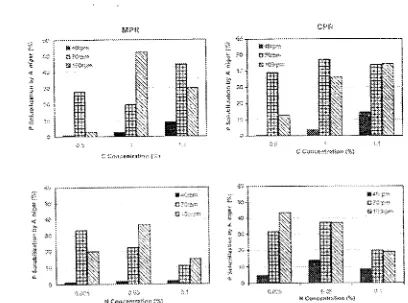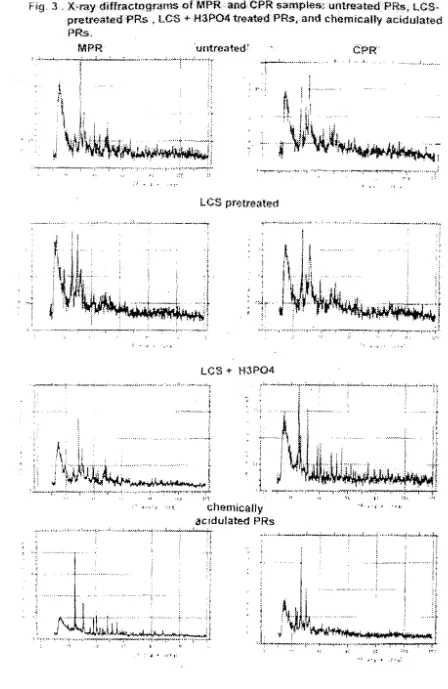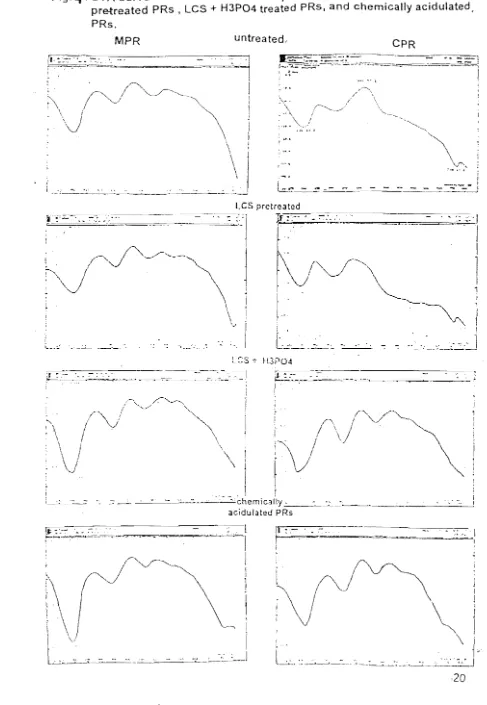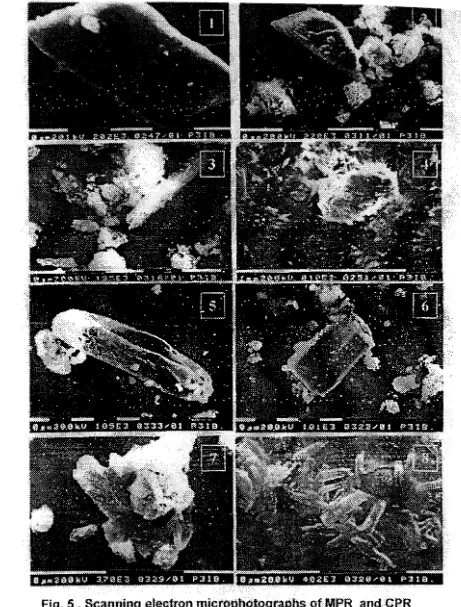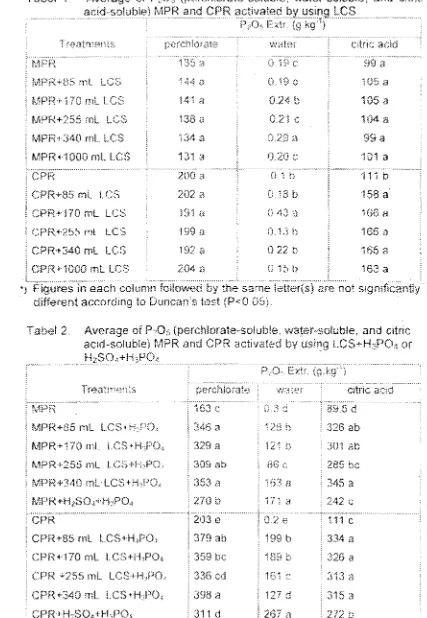Solubility Phosphorus Improvement of Indigenous Phosphate Rocks by Aspergillus Niger
By:ABSTRACT
IIIah Sailah1), Didiek H. Goenadi2), Soewanto2)
1) Agroindustrial Technology Department-Bogor Agricultural University-Indonesia 2) Indonesian Biotechnology Research Center-Bogor-Indonesia
The effectiveness of phosphate-solubilizing fungi (PSF) in improving phosphorus (P) solubility of poorly-soluble phosphate rock (PR) is assumed to be dependent on the suitability of the fungal isolate to the mineralogical suite of the rocks. A laboratory study was carried out to bioactive two mineralogically different hardly-soluble apatitic indigenous PRs by using an organic-acid-producingAspergillus niger BCC F.194. Optimum fungal culturing conditicns for P solubilization were determined by varying the carbon and nitrogen contents of the Pikovskaya broth medium at different shaking speeds. Liquid cultural supernatant (LCS), obtained from the optimum conditions was then reacted with 55g PR, i.e. CiIeungsi and Madura PRs, for the two hours at various concentrations, i.e. 8.5, 17. 25.5, and 34 mI; in combination with 28mL H3P04 (52%) addition. Without LCS addition and conventional superphosphate treatments acted as negative and positive checks, respectively. Phosphate determination included water, 2% citric acid, and perchlorate-soluble P contents. Mineralogical analyses were performed by x-ray diffractometer (XRD), differential thermal analyzer (DT A), and scanning electron microscope (SEM). The use of oxalic-acid-containing LCS in combination with H3P04 increased significantly P solubility of both PRs due to the destruction of hydroxy-and chlorapatite crystals caused by acidification. Hydroxyapatite exhibited a higher response to the treatment than the chlorapatite did. As the soluble P contents are comparable to that of conventional superphosphate, the production of the P fertilizer with a lower acid consumption is possible. To overcome low reactivity of natural phosphate rocks (PR) as P source, several alternatives have been proposed. These include partial acidulation (Hanunond et al., 1986; Bolan et a/.,
1997; Lewis et aI., 1997; Rajan et a/., 1997), synthetic organic acid activation ( Sagoe et aI., 1998), natural organic acid reaction ( Singh and Amberger, 1998 a&b), and decreasing particle size (Goenadi, 1994; Babare et al., 1997). All of these approach were intended to increase P availability to crops grown on acid soils. However, increasing pressure on not-using synthetic chemical products within the last two decades retards the wide application of such alternative. Moreover, endless rise on production cost of conventional superphosphate (SP) cehos the need of a more environmentally safe and economically feasible technology.
More efforts were then spent to utilize microorganisms, especially bacteria and fungi, for improving dissolution of PRo Thien and Myers (1992) showed that bioavailibility of P in a bioactive soils was remarkably enhanced by increasing soil microbial activities. Others have reported that certain soil micrc)bes are capable of solubilizing relatively insoluble phosphatic compounds (Asea et aI., 1988; Nahas et a/., 1990; Goenadi et aI., 1995; Bojinova et a/., 1997). These phenomena have been attributed to the fact that increasing P solubilization of PR was closely related to the ability of the microbes in producing selected organic acids (Kucey, 1983; Illmer and Schinner, 1992; Goenadi et aI., 1993; Omar, 1998; Kim et aI., 1998). Citrate and oxalate were common organic acids reported in these literatures as well as that reported earlier by Banik and Dey (1982). However, the types of organic acids produced have been reported to be dependent on the chemical suites of the culturing medium (Cunningham and Kuiack, 1992), and consequently affecting the effectivness in P solubilization.
Recent study conducted by Goenadi et aI., (2000) indicated that a P solubilizing fungus (pSF) Aspergillus niger grown on Pikovskaya broth enriched with Morrocan PR (MPR) produced citrate. malate, ptalate, and piruvat By applying the liquid culture supernatant (LCS) on MPR, they showed that SP may be produced without sulfuric acids addition. However. the effect of this so-called bioactivation technique on mineralogical change of the PR resulting in the increase of soluble P content has not been clarified. Besides, the consistency of such technique on different types of PR need to be determined. Our objectives was to bioactive two mineralogically different hardly soluble PRs by using an organic-acid-producing A.niger in attempt to develop an effective technique for the production of enviromnentally safe P fertilizer.
INTRODUCTION
Indonesia considered as agricultural country still needs many kinds of fertilizer in huge number. Among the conventional fertilizer, the need of phosphate fertilizer (P) in 2003 almost 2.83 million tons with the value of 2.83 billion rupiahs ( $35.4 M). Unfortunately, almost all of the component is imported materials, especially the natural phosphate as a raw material. Eventhough the domestic natural phosphate is almost one million ton, however its quality is poor due to non reactivity and inconsistent.
The effort to increase the reactivity has been done by utilizing sulfuric acid or phosphoric acid. This technology i!
expensive and also environmental unfriendly. An applied microbiology research results has provided the opportunity t(
utilize the microorganism as an activator in P solubilizing from natural phosphate. This microbe can be able to product the phosphatase enzyme and organic acid for P solubilizing.
Based on the initial research, it is known that citric acid is the dominant agent for P-FAM and FAC in liqui(
culture supernatant (LCS) from Aspergillus niger BCC F.194. By using this techniques, it is expected that the supply 0:
P for can be incfeased without increasing the doses of P fertilizer. The utilizing of direct microbe is not efficient due t<
the needs of time for incubation (Goenadi, 1998). Therefore. the target of this research is the package of techno 109)
utilizing the A. niger for solubility improvement in activation of local natural phosphate.
The objectives of the study are (1) to optimize fungal culturing conditions, (2) to observe the effect of organic
acids on PR dissolution and its bioactivation.
MATERIALS AND METHODS
The step of research were divided into several steps, Le. (1) optimizing fungal culturing conditions for LCS
production, (2) effect of organic acids on PR dissolution, (3) bioactivation ofPR by LCS addition and (4) mineralogical analyses.
Optimizing fungal culturing conditions for LCS production
Optimum conditions for A. niger BCe F.194 (Goenadi et aI., 2000) cultivation were achieved by varying the C and N contents of the PR-contailling Pikovskaya broth medium combined each with different mechanical shaking
speeds, Le. 40, 70 and 100 rpm. Glucose was used as C source given at three levels, i.e. 0.5, 1.0, and 1.5% (w/v).
whereas HセィsPT@ served as N source, i.e. 0.025, 0.05 and 0.1% (w/v). A series of 250 mL Erlenmeyer flasks
containing 100 mL of Pikovskaya broth enriched separately with 0.25% (w/v) Cileungsi PR (CPR) and Madura PR
(MPR) were inoculated by a loop of a 7 -day-old セァ。イ@ (Oxoid L 11) plate culture of the fungus and incubated for 9 days
at room conditions. Chemicals data ofMPR were 71.2 g.kg'] perchlorate-soluble P, 39.1 g.kg,l citric acid-soluble P, 0.1
g.kg'l. water-soluble P, 153.8 g.kg·1 CaO, and 161.1 g.kg,l chlorine (CI), whereas those of CPR were XXNXァNォァMセL@
48.6g.kg'], O.lg.kg,l, 115.5gkg'l, and 41.4 ,respectively, Subsequently, the optimum level of C source was applied to determine the optimlUll level of N source at optimlUll level of aeration obtained by mechanical shaking speed, and finally these two optimum level of nutrient sources were applied to determine the optimum PR concentration for optimlUll growth of P solubilizing ability, and organic acid produced by fungus. Five level or respective PR
concentrations were 0, 1.25, 2.5, 5.0 and 10.0 g.L-1• The growth of the fungus was measured by mycelia dry weight at
the end of incubation period. Phosphorus solubilizing ability was determined by measuring the soluble-P by molybdenum blue method (Olsen and Sommers, 1982) and expressed it as percentage to perchlorate-soluble P of the rock. Organic acids was quantified by high performance liquid chromatography (HPLC) teclmique.
Effect of Organic Acids on PR Dissolution
This experiment was carried out to clarify the relative strength of different types of organic acids in solubilizing P from the PRs used. Citrate, oxalate, and gluconate were separately reacted with CPR and MPR at six levels, 0,0.05,0,50, 1.0,3.0 and 6,0 mM. Each organic acid was added to 50 mL autoclaved water containing 1.25 g.L,1 sterilized CPR or MPR. The mixture was then mechanically shaken at 100 rpm for seven days under room temperature
(IHmer et al., 1995). Perchlorate-soluble P was determined at the end of incubation (Rund, 1984).
Bioactiva,tion of PR by LCS Addition
The LCS obtained from a nine-day old culture of A. niger under the most optimunl cultivation conditions
resulted from previous experiments was then used to activate CPR and MPR Following the procedures reported earlier
(Goenadi, et al., 2000), 55 g of non-sterilized respective PR were reacted with 0, 8.5, 17, 25.5 and 34 mL LCS in 250
rnL erlenmeyer flasks for 2 h. on a mechanical shaker at 100 rpm. The liquid solid ration was kept at I: 1 (v/w) by,
making up the vOlur,ne with sterile deionized water by using the ュ・セッ、ウ@ previously mentioned (Olsen and ウッュュ・イウLセ@
1986). The most OptlmlUll LCS concentratIon was selected on the baSIS of these parameters. Subsequent expenment .. '
carried out to produce superphosphate by using the LCS-activated PRs. A 5,2 g of 80-mesh LCS-pretreated CPR .
MPR was reacted with 28 mL H3P04 (52%) (Young et al., 198'5) for 2 h. and dried by using oven drier.
experiments were arranged in complete Random Design with two replicates. Perchlorate, 2%-citric acid-, and soluble P were observed by using the methods mentioned previously.
[D
.' Mセ@MNセG|@Mineralogical Analyses
Mineralogical analyses were conducted by using x-ray diffrectometer (XRD, Shimadzu), differential therma:
analyzer (DTA, SETARAM), and scanning electron microscope (SEM, PHILLIPS 515). A 200-mesh-size powder キ。セ@
prepared prior to the analyses. The samples included those ofLCS treated, or untreated, and of conventional SP (SP-36 PT Petrokirnia Gresik) which were constructed from both of CPR and MPR. Parallel-oriented sample were performeci
for XRD analysis using Cu-Ka radiation at 30 kV and 30
rnA
as reported by Brindley and Brown (1980) and Goenadi(1991). DTA was performed with one mg sample against tW'o rag inert Al203 employing a heating rate 15°C/min
(Goenadi. 1989). Micro visualization of sample was carried out by SEM observation after gold coating by TAAB coating sputter (Goenadi and Tan, 1991).
Statistical Analyses
Statistical analyses was conducted using Duncan Multiple Range Test (DMRT) (p=O.05) to determine
significant difference of the mean values between treatments. Regression and correlation analyses were performed to determine the relationship between soluble P contents and pH of the medium, fungal, biomass, and organic acid concentration.
RESULTS AND DISCUSSION
Optimizing Fungal Culturing Conditions for LCS Production
Optimum condition for fungal growth in in-vitro medium are influenced by the composition of the medium,
particularly C and N concentrations (Narisan et al., 1995). The rate of oxygen supply into the culturing medium was
also reported affecting the growth of fungal isolate, such
as
Aspergillus niger (Hlmer and Schinner, 1992). Our datashowed in agreement with these phenomenon. The highest ability of A. niger BCC F.194 isolate used in solubilizing P of CPR and MPR was achieved at 100 g.L,1 glucose, 50 g.L,I(N1LhS04. af!d shaking speed of 100 rpm EMPR) and 70
rpm (CPR) (Fig 1).
Phosphate solubilization mediated by phosphatase enzyme is believed to be taken for organic P sources (Spiers
and McGill, 1979; Bishop er al., 1994), these investigators and oth'ers considered that the inorganic P biosolubilization
is governed by the organic acids produced by P-solubilizers. Employing the optimum C and N concentration of
Pikovskaya medium, the A niger BCC F.194 produced oxalic acid as the main organic acids ranging from 0.06 to 3.75
mM. These values, obtained by using HPLC (0.01 N H2S04 mobile phase, 2'10 nm {.TV detector, 0.5 WL.min,l flow rate.
at 50°C was resulted from MPR or CPR as P-source of Pikovskaya medium at 12.5 g.L,1 level. Figure 2. shows the relationship among PRs concentration and P-solubilizing ability and either pH of the medium, fungal biomass, or oxalic acid produced. Regression aualysis indicates that P-solubilization was highly correlated with oxalic acid concentration (rMPR == 0.92" and rCPR==0.85) as well as with the pH of the medium (rMPR ==-0.87' and rCPR"'-099"). Our data also
showed that oxalic acid concentration were strongly correlated with the pH of the medium (rMPR
=
-0.99" and rCPR=-0.87\
Effect of Organic Acids on PR Dissolution
To confirm the relationship between organic acid concentration and the P-PRs solubilization, a range of synthetics organic acids concentration (up to 6 111M), i.e. oxalic, citric, and gluconic acids, was reacted with MPR and
CPR. It was evident that oxalic and citric acids have strong influences to the solubilization of P-PRs, i.e. rMPR := 0.96'·
and rCPR=0.97"(oxalic acid) and rMPR == 0.96'· and r CPR==0.99* (citric acid). These phenomenon lead to the assumption
that oxalic acid produced by A.niger BCC F.194 isolate is responsible for lowering the pH of medium providing more
protons (W) to increase the P-PR solubilization. This assumption is based on what Illmer and Schinner (1992 and 1995)
have postulated that the production of organic acids is an important mechanisms for solubilizing relatively insoluble P,
but they believed that this is not the only possible one. Another possibility would be the release of
W
from thecytoplasm to the outer surface which may happen in exchange for cation (especially セI@ uptake or with the help
W
translocation ATPase which is located in the plasma lemma and uses the energy for A TP hydrolysis.
Following the above hypothesis, those authors assumed that PR would be solubilized directly at the cell
surface. If this is the case, then the mycelial
dry
weight will correlate closely with the soluble P. By using the samefungal isolate, Goenadi et aI., (2000) showed that tlle amount of soluble P of Morrocan phosphate rock was closely
related to the fungal biomass within 14 days of CUlturing. Our current findings indicate interesting evidence. As
indicated on Fig 2. the higllest amount of soluble P-MPR was achieved at pH 4 to 5, whereas the value was obtained at pH=2 for P-CPR. Tlus differences implies the pH buffering capacity of the rocks. Cileungsi PR has lower pH buffering
capacity that of Madura PR as セィ・@ later contained calcium (18.3%
Ca++)
higl)c,i that the fonner (8.3%Ca).
Bioactivation of PR by LCS Addition
Data shown in Table I provide evidence in which the addition of LCS improved the water-soluble P of 1 PRs investigated. In contrast, improvement on citric acid-soluble P was only obtained from LCS-pretreated (
Practically, the improved water-soluble P is not significant as it was much less than 10 g.kg-I. However, this incn
indicate to some extent the degradation of P-bearing mineral due to the addition of oxalic-acid-containing LCS.
both PRs the optimum LCS treatments was achieved at 170 mL LCS.kg-1 addition. This level was then used for fur
experiment.
In commercial practice superphosphate (SP) is produced by reacting a 200-mesh PR (P20s>280g.kg-l) ,
H2S04 (98%) and H3P04 (52%) (Young et al., 1985). The mass composition of these materials are 52% PR and L
acids, i.e. 15.5% H2S04 and 32.5% H3P04 However, some variations in the mass composition may occur at indus
practices depending on the grade of the rock and/or the acids. Goenadi et aI, (2000) has shown that the acidulation'
H2S04 can be potentially replaced by LCS in the formulation of Morrocan-PR-originated SP. Data presented in Tab
show that the addition of LCS replacing H2S04 input significantly improved the P solubility of both MPR and C
Although this improvement in water-soluble P was still lower than those yielded by the conventional teclmique, but increase in citric- acid-soluble P was either similar or higher. These results were in agreement with those repo
previously (Goenadi et al., 2000). Considering tile higher contents of perchloric-acid-extractable P of the I
pretreated PRs compared to those of standard process, the bioactivation of PR may be conducted by lowering
concentration ofH3P04.
The improvement of P-solubility of acidulated or bioactiv
bioactivated PR is assumed to be related Witll tile degradation of tile P-bearing minerals, i.e. hydroxyapatite
chlorapatite, due to acid introductioll. Stoichiometrically, acidulation introduces an acid into the system which I
attack the stability of apatitic minerals. Introduction of
H'"
ion is capable of altering tile crystallographic structure ofminerals, possibly shortening tile mineral's axes and/or decreasing crystalline size, resulting in a more P20, in soh
form (Goenadi et al., 2000). Mineralogical analyses indicate that acidulation caused the reduction of XRD p
intensity of apatitic minerals (Fig 3.). On the other hand, tile treatment intensified the two main endotllennic pe present at 150-200 °C and 250-400°C temperature (Fig. 4). These phenomena may be attributed to the reductiOl
crystallite size
;is
evidenced by the SEM microphotographs (Fig. 5). As shown in Fig. 5, tllese acidulation either by 1+ hSpoセ@ or hLウッセ@ + H3P04 .resulted in the formation of smaller crystallite of P-bearing rninenUs.
CONCLUSIONS
The utilization of oxalic-acid-containing LCS, produced by nine-days-old culture of A. niger BCC F.194
combination with I-hP04 increased significantly soluble P conients of both MPR and CPR. Improved solubility of tt
indigenous PRs was attributes to the destruction of hydroxy-and chlorapatite crystals caused by acidulation. Emplo)' tllis LCS bioactivation technique, a more ecological friendly P fertilizer tllan conventional SP can be yielded. Howe' tile agronomic effectiveness of this product requires furtller studies.
REFERENCES
• Asea, P.E.A, RM.N. Kucey, and 1. W.B. Stewart. 1988. Inorganic Phosphate Solubilization by Two Penicilli Species in Solution Culture and Soil. Soil Biol.Biochem. 20(4):459-464.
• Babare, A.M., P.W.G. Saie, N. Fleming, D.L. Garden and D. Johnson. 1997. The Agronomic Effectiveness Reactive Phosphate Rocks 5. The effect of particle size of a moderately reactive phosphate rock. Aust. 1.Exp.Ag 37:969-984.
• Banik, S. and B.K. Dey. 1982. Available Phosphate Content of an Alluvial Soil as Influenced by Inoculatior some Isolated Phosphate-solubilizing Microorganism. Plant and Soil. 69:353-364.
• Bojinova, D., RVelkova, I.Grancharov and S.Zhelev. 1997. The Bioconversions of Tunisian Phosphorite us Aspergillus niger. Nut. Cyc. Agroecosyst., 47(3):227-232.
• Bolan, N.S., 1. Elliot, P.E.H. Greff, and S. Weil. 1997. Enhanced Dissolution of Phosphate Rocks in Rhizosphere. Biology and Fertility of Soils. 24(2): 169-174.
• Cunningham, 1.E. and C.Kuiack. 1992. Productions of Citric and Oxalic Acids and Solubilizations of Calci
Phosphate by Penicillium bilaji. App.Env.Microbiol. 58(5): 1452-1458.
• Goenadi, D.H., and K.H. Tan. 1989. Micromorphology and Mineralogy of Illuviated Clay in Davidson soil. セ@
Sci. Soc. Am.1. 53:967-971.
• Goenadi, D.H., R Saraswati, N.N. Nganro, and 1.A.S. Adiningsih. 1995. Alikroba pelarut hara dan peman
agregat dari beberapa tanah tropika basa. Menara Perkebunan, 63(2):60-66.
• Goenadi, D.H., Siswanto, and
Y.
Sugiarto. 2000. Bioactivation of Poorly Soluble Phosphate Rocks with;Solubilizing Fungus. Soi1.. Sci. Soc.Am.1. 64:927-932.
• Hammond, L.L., Chien, S.H. and Mokwunye, AU. 1986. Agronomic Value of Un acidulated Phosphate Rocks Indigenous to the Tropics. Advances in Agronomy. 40:89-140.
• Illmer, P. and F. Schinner. 1992. Solubilization of in Organic Phosphate by Microorganisms Isolated from Forest Soils. Soil Biol.Biochem. (24):389-395.
• Illmer, P., A Barbato, and F. Schinner. 1995. Solubilization of Hardly-soluble AIP04 with Solubilizing Microoganisms. Soil Biol.Biochem. 23(3):3265-270.
• Kim, K.Y., D. Jordan, and AG. McDonald. 1998. Effect of Phosphate-solubilizing Bacteria and Vesicular-arbuscular Mycorrhizae on Tomato Growth and Soil Microbial Activity. Biol.Fertii.
• Kucey, RM.N. 1983. Phosphate-solubilizing Bacteria and Fungi In variolls Cultivated and Virgin Alberta Soils Can. l Soil. Sci. (63):671-678.
• Lewis, D.C., P.w.G. sale and D. Johnson. 1997. Agronomic Effectiveness of Partially Acidulate Reactiv{ Phosphate Rock Fertilizer. Austr.lExp.Agric.37:985-993.
• Nahas, E., D.A Banzatto, and L.c. Assis. 1990. Fluorapatite Solubilization by Aspergillus niger in Vinase
Medium. Soil Biol.Biochem. 22: 1097-11 0 I.
• Olsen, S.R and L.E. Sommers. 1982. Phosphorus.
in
AL. Page et al. (eds) Methods of Analyses 11. Chemical ancMicrobiological Properties. Agron. Monogr. No 9. 2nd. Am. Soc.Agr.Madison.
• Omar, S.A 1998. The Role of Rock-phosphate-solubilizing Fungi and Vesicular-arbuscular-mycorrhizae (V AM) in
growth of Wheat Plants Fertilized with Rock Phosphate. World l Microbiolo Biotechnol. 14(2):211-218.
• Rajan, S.S.S. and A Ghani. 1997. Differential Influence of Soil pH on エNセ・@ Availability of Partially Sulphuric and
Phosphoric Acidulated Phosphate Rocks. 2. Chemical and Scanning Electron Microscope Studies. Nut. Cys. Agroecosyst. 48(3): 171-178.
• Sagoe, c.r., T. Ando, K.Kauno, and T. Nagaoka. 1996. Response ofItalian Ryegrass to Prosphorus in Organic-acid
Treated Phosphate Rocks. lFac. Appl.Bioi. Sci. 35:199-209.
• Singh, c.P. and A Anlberger. 1998. Solubilization of Rock Phosphate by Humic Acid and Fulvic Acids Extracted from Straw Compost. Agrochimica 41:221-228.
• Thien, S.l andR Myers. 1992. DetemlinationofBioavailable Phosphorus in Soil. Soil Sci. Soc. Am.I. 56:814-818.
セ@ Young, R.D., D.G. Westfall, and G.W. Colliver. 1985. Production, Marketing and Use of Phosphate Fertilizers. P
jセMSWVN@ in O.P.Engelst;ln. (ed) Fertilizer Technology and Use. 3rrl. SSSA, Madison. Wr.
cpfセ@
,"-, : ... -.. MセMMMMセMMM ...
--...,
<;::.,._ ... _-セ@ !;-:.:: GセG@ t.. {:.
e
Nセセ@""
::: "セ@
セ@"
セ@ v, "-セNZNセ@ セセセZ@ GセセB@ Z:) ...- - - -... · .. · ... · .. ·· .. - - - , 3
NセZNZZZセLLZ@ 1
」[ᄋᄋセZᄋセᄋZB@
I
c
ZセNZZ[GZ@.. "' ..
I
イセGB@
;
" .L,...l:ll.£M:iI .• __ ... IJez,;"::..L. .. _
oS:
t LZセ@
" ,-;-:q ::.-:.:
:>::
----,
.... _.,. ... ..::?
(J
Aセ@ iャャLセ@ セ@
;,1
セ@
... "J .. _
....
⦅NZZiGNLN[[NNNゥNセ⦅L[ZLN@
...セヲZ@
1: セセGZ@
:'1.
Nセ@
Fig. I.
t· ZNセセZ@ N Cu(,.;t!afC': .. セ[NᄏIセ@ HカセA@
rv1PR· (lett) "in;:! CPR .. (right) SOlubilizing ability of A nirr'}{ BeC
F .194
-3t
different $haldr,g rate (rpm), cmbor; conce.:ltr8ticf\(atJcl)(;)' and nitrogen Goncentrat;on HィセAo|エケᄋI@
[image:5.599.125.533.408.711.2]
,,,-セセ_GNN@
f
;;...
.. <;
'"'
v'
; ....
セ[[@
セZ@
'"
:f-:;,:
..
{) " :,'
N[Zセ@
L[NセN@
?;:
NQセA@
<'-,
セNG@ .
.0
セ@.
.;:
'.,
;
セL@
NNセGB@
セG@
セ@
<,";.
'.'
:.," . . "
,i
スセMG@
セZZ@
-:;
Lセ[@
[セGZセ@
;)..
't,;
r"t9. 2.
'f'he
ZZェ[ャイZセセヲョ[GHスセ@ ()fF; ...
fセr@ ZZセcᄋォIエセhゥエZセZ。エ[Hhャ@arid
f)H
\Nエ」セーIL@ ftJflgal(;iOrnBSs
Hュゥ、、ォセl@.:;')n:1
ッLZZセLセゥ」@ac:d
f)!'oduceo
(tmHGm) at
、ゥヲヲセセイ・ョエ@,e,'j セ\iGBB@ (\f' I' <1 Df:)
r
',,:·fn
ZLセGGGョ@('
r,lp i!';;,·!'··t)' HGセjG@ rv'.,.,' .... エャGMZZウエャLNNGAMMャᄋセセ@ :,)fl·C1" Gt"'
.',tセG@ ... F,:,t;., .. セ@ NセN[G@ LセセZ@ "\. |セMGGGセ@ .... .. セNH@ QGセI@ -",I BセB@ NセセNャ@ _ ;,.; ... セ@.... セス@ .. <':'-l \.,) .. '" '" ャセL[B@ セNB@ .. A ,,,!
Fig.
:3 ,
xセイ。ケ、ゥヲヲイ。」エLYYイTョャs@of
MPRal1dCPR
ウ。ャQQーャ・DAオョエエ・。エ・、prウセ@ lcsセ@pretreatedPR,s , Les
-I-H3P04
treated>PRs,and
chemicanyacidulated
PR$..
MPH
Gオョエイ・。エ・、セ@CPR'
.+-4... ...
セ@...
セN⦅@.... ".
s · . ; ,_ .),i;
,
• p ;
, セ@ セBBBBヲGGGGyGGGGGセ@ ... セ@ .. ··'t....,."" .... ···;-· ... GᄋᄋセᄋセセᄋQ@ ... ·"'·"'··· .... ᄋᄋサセ@
. '
::': ,: , ,... . '. :'
L CS pretreated
[image:7.604.95.543.83.772.2]LCS
+H3P04
... ,'!
,
,
Nセセ@ ... -... ..
;
... .,.
セG@ :
.
:
H
ゥ|セセセjlャL@
:""
!
lj .; (Vi セセセN@
セ@ セ@ ... ᄋセセセ@ ... LセセᄋNᄋᄋセ@ .. Mセ@ ... l .... セ@... MMセ@ . ,", '-.' セ@ セL\N@ セGB@ • ... ᄋMZセャ@ ... MᄋᄋvNセセZl@
.. { .q. ーセ@
" " ' ' ' t
chemically
acidulated PRs. .{:
",", セ@
...
' .. ' セN@' - - ' - - . : . . •• - - : . -.... " ... - .... ;;<!."' ... セBG@ .... + ... Mセ@ .... ;"'!
.,
, サセ@ .;
1 .
.... セNGセ@ ..
,
セ@ l::(
... m_.-. .. ( ,
n
セ@
セ@ セ@
セ@ ! (
.... " , : ZセスL@ ᄋセゥ@
LLセ@ セBB@ J> ' .. セN@
NセZ@
... セ@
... セ@
... ;-...
セ@....
セ@... "
... セセKGィNセセセセ@
: ; ., セ@ ... セ@.••. GMNャNLNNセ@ .... ; _ _
:_.i .... '" ...
セ@...
セ@.. ,
...
セ@."'."-"',,-..
セ@.... '".-.;. ...
-h-. セ@
U
, ... 1'.,
··t···· ....
:,',wセBliiZ@
... , ..•..
: i
J
uセNNゥ[セL|iuォセェ@
セセᄋBセMNᄋNケ@ ... N ... セ@ ... :;'..-... セ@ ... Gセセ@ ... -.. セ@. . . . · ' •• セ@• • • • • • ?"" .
. :-; )- {.
Fig.4.
DT A curvesof
MPR and CPR samples: untreated PRs,LCS-pretreated PRs , LCS
+
H3P04 treated PRs, and chemically acidulated.\
i
l⦅セG@
PRs.
MPR untreated, CPR
. "
..
\
: ....\
-セM|@
I
セA@
I.,
I
i .
..
セセMG@
セセ@
..
セB@ MZZ⦅NMZZZ⦅N⦅ZMNNセM[@
. __ .' I
エMセ⦅@
_
__
MMMGMMNNNZZNNNNNNNNZNMMM]MNNZZZZNNM]NZセN@
Oセ@
lNNセsセᄋ@ H3P04
,.
r;
rv\
セ@
acidulated PRs
-nle Arab Fertilizer Association
20
$
ᄋャ
ZᄋNᄋNᄋᄋᄋᄋセ@
.,
fig.
UNs」。ョBゥヲャァ・ィjYエイッNョュゥ・エセーエャYエアYエセーィsoヲmpr@
3ndCRR.
ウ。ューエ・ウセオョエュヲャエ・、prセHQᄋFセQェエ・ウ@
..
pretr&ated·
prウサセFVIL@
lCS
+113P04treatedPRs(3&7),
and
ehemicaUyatidulated
PRs(4&S).
[image:9.599.93.554.64.671.2]Tabel· 1
Average
of
P::O'3 (perchlorate-solUble,
water··solub}e,
and citric
[image:10.599.114.541.111.729.2]add··soluble)
tv1PH
and CPR activated bV using LCS .
... ... " ... ... ..." ...
BゥGIIェ[ZヲZZN[[エイNH[セBセZァZQIB@...
"..NMPH+ 170 mL
I.e;:.;
r,JlPR+255
,nl
LCSCPRf·85 rnL
LeG
CPR+HO
rnl
LCScprMエGRセIs@
mL LCS
CPR+340 mL lCS
CPR+1000!TIL LeG
D, '18
043
o.n
0.22
each
c()h.mm
by the same
different according
to
Duncan's
エエセウエ@(P<O.05).
104 a
b
'158
a
8 166
a
b
166
a
'"
u
165
a
Tabel 2.
Average of P:::,O;', (perchlorate··solub!e, water-soluble, and citric
aCId-soluble) MPR and CPR activated by using
lcsKhZpoNセ@or
...
エセNRLPアセセiェスpNYNセ@
...
... :
...
N N . N . . . " . . .i r,.lIPR+f)S rnL ャcsセhZpoNZ@
: I'vlPR+FO mL LCS
+H::PO'
1l
MPR+255 rnL LCS+I"U::''C},? MPH+340
rnL·lC:::i
KhᄋセAセGoB@E'"
f'" (/"t セ@ Nセ@ ... ;, ..X\:, エLセQNエセ@ )
:,. " ... , ... . " " .... ".
perchlorate
" ••••• :--.> --- .. -•• -••.•••••
: -<I r<"\. f'
セ@ vv ....
,
I
346
a
: 329
a
: 309 ab
; GセサIセGj@ 1')
: , ... ' t>
'. 270 b :
セ@
' V <citric ac:,d
j 89.5 d
: 326 ab
: 28S bc
: 345
a
"',;,.: "2' ;)
..
Zセ@ [セ@
...
'I:"BZセ@
I. ' ) . 'BNLセNZQ@
イイェェZIrセ@
...
-.w .... " ... ".n... , セ@ ;;; , セZ@ £. "" .·.·.'·'··m.·,·.'.· ... · ... · .... , ... ,.? : セ@
l
cphKXセセ@ mLLCS'I-H)POl
.• CPH'+-170 rnL
I.CS+HP04(PH -.;.255 rnL
LCS·j·H:PCL
セ@ 17ct
a
i) ! 1t)O bセNNN@ . . , . . セ@ ! '"" v
j
336 cd
lB9 b
!
1G1
c
: 1 "'-
f .:;J" r!1 ,_'-._
. ! tJ){
a
.
: 311 zi
: I :
·j··F:{gi'j·res·,·n·each
coャャャイQQョGヲ、ェッセカ・、B「ケ@
エィHセ@
ᄋウ。ゥョ・ᄋᄋゥセセエエサセᄋイサsイ。ヲ・ᄋゥゥᄋH[ゥᄋᄋᄋᄋウᄋゥァョゥヲゥ」。ᄋョエェケ@
、ゥヲヲ・ョNセョエ@
according to Duncan's test
(P<O.05)
